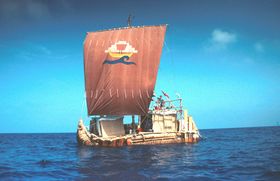2022 – 20 Jahre nach ABORA II
Erinnerungen an eine wichtige Expedition
Presseinformation ABORA-Projekt - 08. März 2022 - www.abora.eu Kontakt: Dr. rer. nat. Dominique Görlitz; +49 163 511 57 66 oder dominique.goerlitz*at*t-online.de
(dg) Unbemerkt der vielen Jubiläen in 2022 zelebrieren wir dieses Jahr natürlich auch die Seereise der ABORA II aus dem Jahr 2002. Zum zweiten Mal starteten wir eine ABORA-Mission, bei der ein Schilfboot konsequent nach vorgeschichtlicher Felsbildvorlage mit Seitenschwertern an Bug und Heck aufgetakelt wurde. Im Unterschied zu allen Heyerdahl-Expeditionen sollte ABORA II deshalb eine geschlossene Hin- und Rückexpedition absolvieren, um die volle Manövrierfähigkeit dieser Segelflöße zu dokumentieren.
Nach Vermittlung der ehemaligen Direktorin des KON TIKI Museums Oslo Frau Maja Bauge starteten wir unser Experiment in der antiken Hafenstadt Alexandria. Zufall oder nicht – die Seereise startete exakt am 18. Mai 2002 zum Nationalfeiertag der Norweger. Leider erlebte der berühmte Norweger Thor Heyerdahl diesen Start nicht mehr, weil er unmittelbar nach dem Stapellauf an einer schweren Erkrankung in Italien verstarb.
Mit der Überfahrt in den Libanon (Beirut) und dem Übersetzen nach Zypern (Larnaka & Limassol) setzte das neue Schiff schon ein erstes Achtungszeichen. Das Highlight setzte aber die Rückfahrt von Zypern nach Ägypten im Spätsommer 2002. In dieser Jahreszeit wehen die Winde mehr aus nordwestlichen Richtungen und es war klar, dass die Mannschaft nur durch Aufkreuzen das Schiff zurück zum Hafen nach Alexandria segeln konnte.
Die Crew vollbrachte mit extremer Teamarbeit diese Leistung. Mehr als 19 Tage lang kreuzte sie vor der afrikanischen Küste auf und ab. Die Fahrt belegte zum ersten Mal seit Thor Heyerdahl, dass altertümliche Schilfflöße nicht nur hochseetauglich, sondern auch voll manövrierfähig waren. Die Seitenschwerter an Bug und Heck verwandelten die ABORA II von einem primitiven Segelfloß in ein Hochseegefährt, das zu jedem beliebigen Ort auf der Welt hätte segeln können. Und sie war im Stande auch wieder zurückkehren!
Für mein ABORA-Projekt brachte die ABORA II Mission die Wende und gleichzeitig erfüllte sie das Vermächtnis von Thor Heyerdahl. Die Ozeane waren keine Barrieren, sondern maritime Transportbänder, über die die frühgeschichtlichen Völker in Verbindung standen.
Die Takellage wurde nach Vorlage der prädynastischen Negada-Kultur (ca. 3.800 bis 3.100 v. Chr.) konstruiert. Diese Leute stellten mehrfach Schilfflöße mit Seitenschwertern an Bug und auch am Heck dar. //
The rigging was designed based on the predynastic Negada culture (ca. 3,800 to 3,100 BC). These people repeatedly depicted reed rafts with leeboards at the bow and also at the stern.Die Geheimwaffe der ABORA II: Vier Paar Schwerter am Bug und drei am Heck. Durch gezieltes Einsetzen konnte man dem Winddruck über Wasser, unter Wasser Widerstand entgegensetzen. //
The secret weapon of the ABORA II: four pairs of swords at the bow and three at the stern. By using them in a targeted manner, you could resist the wind pressure above water and under water.Die Expeditionsroute der ABORA II. Die schwarzen Pfeile zeigen die mittlere Windrichtung in den entsprechenden Seegebieten. Besonders auffällig sind die Kurse auf dem Rückweg von Zypern nach Afrika. Der erste empirische Nachweis, dass Schilfboote auch Aufkreuzen können. //
The expedition route of the ABORA II. The black arrows show the mean wind direction in the corresponding sea areas. The courses on the way back from Cyprus to Africa are particularly striking - the first empirical evidence that reed boats can also tack against the wind.Die ABORA II auf ihrer Rückfahrt nach Alexandria. Am Steuer unser norwegischer Partner und Sponsor Arne Osmundsvaag aus Asker nahe Oslo. Er hatte mit seiner Firma den Großteil der Expedition finanziert. //
The ABORA II on her way back to Alexandria. At the steering was our Norwegian partner and sponsor Arne Osmundsvaag from Asker near Oslo. He had financed most of the expedition with his company.
+++++++++++++++++++++++++++++++++++++++
2022 – 20 years after ABORA II
Memories of an important expedition
Unnoticed by the many anniversaries in 2022, we are of course also celebrating the sea voyage of the ABORA II from 2002 this year. For the second time we started an ABORA mission, in which a reed boat was rigged with leeboards on the bow and stern, consistently based on prehistoric rock art. In contrast to all Heyerdahl expeditions, ABORA II should therefore complete a closed outward and return expedition in order to document the full maneuverability of these ancient sailing rafts.
After mediation by the former director of the KON TIKI Museum Oslo, Ms. Maja Bauge, we started our experiment in the ancient port city of Alexandria. Coincidence or not – the sea voyage started exactly on May 18th, 2002, the Norwegian national holiday. Unfortunately, the famous Norwegian Thor Heyerdahl did not live to experience this voyage because he died of a serious illness in Italy immediately after the launch in April 2002.
With the crossing to Lebanon (Beirut) and the crossing to Cyprus (Larnaka & Limassol), the new ship already made its first mark of respect. The highlight, however, was the return trip from Cyprus to Egypt in the late summer of 2002. At this time of year the winds were blowing more from the north-west and it was clear that the crew could only sail the ship back to the port in Alexandria by tacking up.
The crew accomplished this feat with extreme teamwork. For more than 19 days, she tacked up and down the African coast. The voyage proved for the first time since Thor Heyerdahl that ancient reed rafts were not only seaworthy, but also fully manoeuvrable. The lee boards at the bow and stern transformed the ABORA II from a primitive sailing raft into an ocean-going sailing craft that could have sailed to anywhere in the world. And she was able to return again!
The ABORA II mission was the turning point for my ABORA project and at the same time fulfilled Thor Heyerdahl's legacy. The oceans were not barriers, but maritime conveyor belts that connected ancient peoples.




